The NVIDIA GeForce GTX Titan X Review
by Ryan Smith on March 17, 2015 3:00 PM ESTCompute
Shifting gears, we have our look at compute performance.
As we outlined earlier, GTX Titan X is not the same kind of compute powerhouse that the original GTX Titan was. Make no mistake, at single precision (FP32) compute tasks it is still a very potent card, which for consumer level workloads is generally all that will matter. But for pro-level double precision (FP64) workloads the new Titan lacks the high FP64 performance of the old one.
Starting us off for our look at compute is LuxMark3.0, the latest version of the official benchmark of LuxRender 2.0. LuxRender’s GPU-accelerated rendering mode is an OpenCL based ray tracer that forms a part of the larger LuxRender suite. Ray tracing has become a stronghold for GPUs in recent years as ray tracing maps well to GPU pipelines, allowing artists to render scenes much more quickly than with CPUs alone.
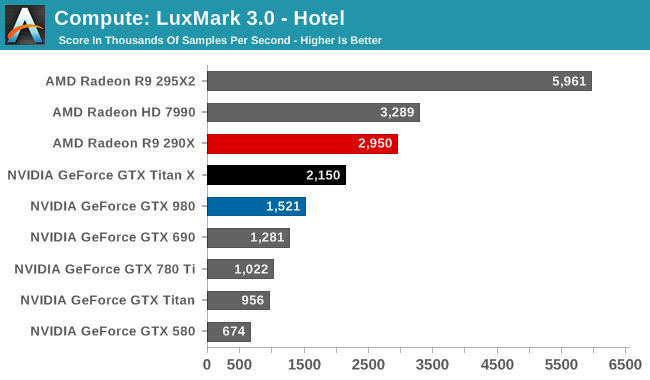
While in LuxMark 2.0 AMD and NVIDIA were fairly close post-Maxwell, the recently released LuxMark 3.0 finds NVIDIA trailing AMD once more. While GTX Titan X sees a better than average 41% performance increase over the GTX 980 (owing to its ability to stay at its max boost clock on this benchmark) it’s not enough to dethrone the Radeon R9 290X. Even though GTX Titan X packs a lot of performance on paper, and can more than deliver it in graphics workloads, as we can see compute workloads are still highly variable.
For our second set of compute benchmarks we have CompuBench 1.5, the successor to CLBenchmark. CompuBench offers a wide array of different practical compute workloads, and we’ve decided to focus on face detection, optical flow modeling, and particle simulations.
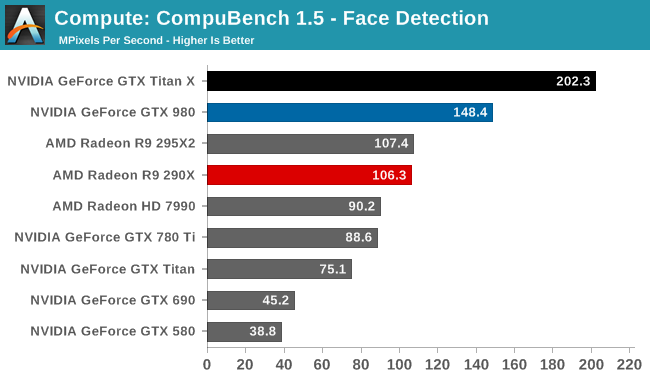
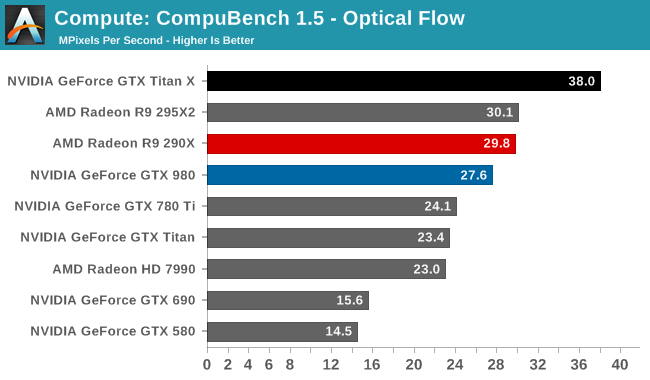
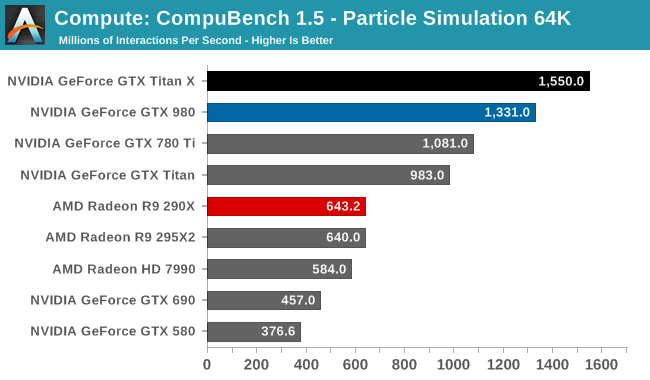
Although GTX Titan X struggled at LuxMark, the same cannot be said for CompuBench. Though the lead varies with the specific sub-benchmark, in every case the latest Titan comes out on top. Face detection in particular shows some massive gains, with GTX Titan X more than doubling the GK110 based GTX 780 Ti's performance.
Our 3rd compute benchmark is Sony Vegas Pro 13, an OpenGL and OpenCL video editing and authoring package. Vegas can use GPUs in a few different ways, the primary uses being to accelerate the video effects and compositing process itself, and in the video encoding step. With video encoding being increasingly offloaded to dedicated DSPs these days we’re focusing on the editing and compositing process, rendering to a low CPU overhead format (XDCAM EX). This specific test comes from Sony, and measures how long it takes to render a video.

Traditionally a benchmark that favors AMD, GTX Titan X closes the gap some. But it's still not enough to surpass the R9 290X.
Moving on, our 4th compute benchmark is FAHBench, the official Folding @ Home benchmark. Folding @ Home is the popular Stanford-backed research and distributed computing initiative that has work distributed to millions of volunteer computers over the internet, each of which is responsible for a tiny slice of a protein folding simulation. FAHBench can test both single precision and double precision floating point performance, with single precision being the most useful metric for most consumer cards due to their low double precision performance. Each precision has two modes, explicit and implicit, the difference being whether water atoms are included in the simulation, which adds quite a bit of work and overhead. This is another OpenCL test, utilizing the OpenCL path for FAHCore 17.
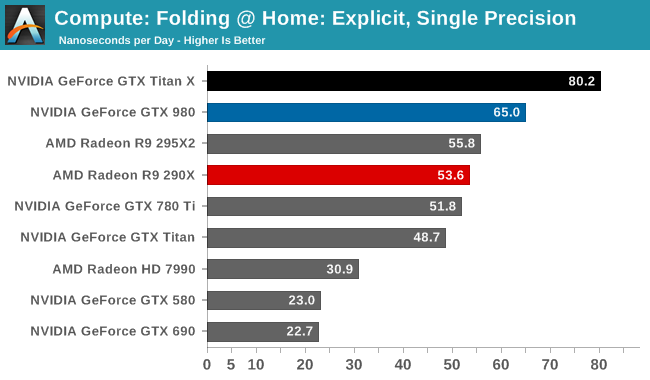
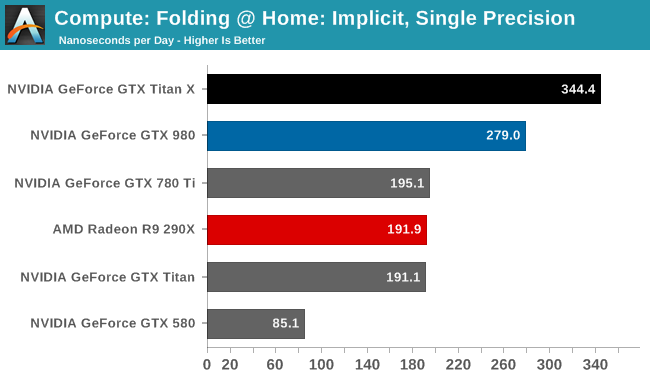
Folding @ Home’s single precision tests reiterate just how powerful GTX Titan X can be at FP32 workloads, even if it’s ostensibly a graphics GPU. With a 50-75% lead over the GTX 780 Ti, the GTX Titan X showcases some of the remarkable efficiency improvements that the Maxwell GPU architecture can offer in compute scenarios, and in the process shoots well past the AMD Radeon cards.
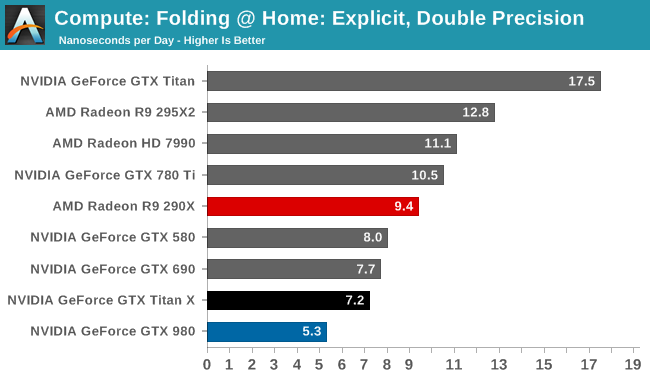
On the other hand with a native FP64 rate of 1/32, the GTX Titan X flounders at double precision. There is no better example of just how much the GTX Titan X and the original GTX Titan differ in their FP64 capabilities than this graph; the GTX Titan X can’t beat the GTX 580, never mind the chart-topping original GTX Titan. FP64 users looking for an entry level FP64 card would be well advised to stick with the GTX Titan Black for now. The new Titan is not the prosumer compute card that was the old Titan.
Wrapping things up, our final compute benchmark is an in-house project developed by our very own Dr. Ian Cutress. SystemCompute is our first C++ AMP benchmark, utilizing Microsoft’s simple C++ extensions to allow the easy use of GPU computing in C++ programs. SystemCompute in turn is a collection of benchmarks for several different fundamental compute algorithms, with the final score represented in points. DirectCompute is the compute backend for C++ AMP on Windows, so this forms our other DirectCompute test.
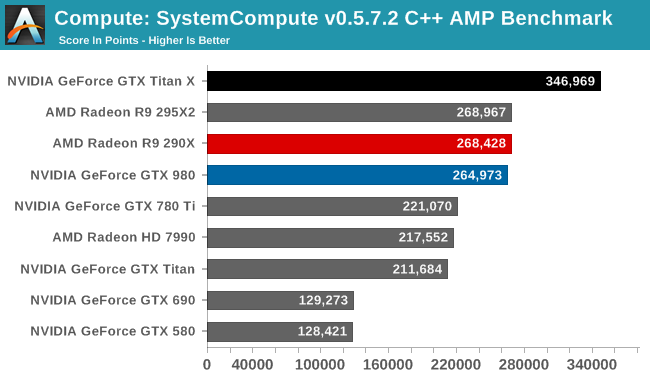
With the GTX 980 already performing well here, the GTX Titan X takes it home, improving on the GTX 980 by 31%. Whereas GTX 980 could only hold even with the Radeon R9 290X, the GTX Titan X takes a clear lead.
Overall then the new GTX Titan X can still be a force to be reckoned with in compute scenarios, but only when the workloads are FP32. Users accustomed to the original GTX Titan’s FP64 performance on the other hand will find that this is a very different card, one that doesn’t live up to the same standards.










276 Comments
View All Comments
chizow - Wednesday, March 18, 2015 - link
And custom-cooled, higher clocked cards should? It took months for AMD to bring those to market and many of them cost more than the original reference cards and are also overclocked.http://www.newegg.com/Product/ProductList.aspx?Sub...
Like I said, AMD fanboys made this bed, time to lie in it.
Witchunter - Wednesday, March 18, 2015 - link
I hope you do realize calling out AMD fanboys in each and every one of your comments essentially paints you as Nvidia fanboy in the eyes of other readers. I'm here to read some constructive comments and all I see is you bitching about fanboys and being one yourself.chizow - Wednesday, March 18, 2015 - link
@Witchunter, the difference is, I'm not afraid to admit I'm a fan of the best, but I'm going to at least be consistent on my views and opinions. Whereas these AMD fanboys are crying foul for the same thing they threw a tantrum over a few years ago, ultimately leading to this policy to begin with. You don't find that ironic, that what they were crying about 4 years ago is suddenly a problem when the shoe is on the other foot? Maybe that tells you something about yourself and where your own biases reside? :)Crunchy005 - Wednesday, March 18, 2015 - link
@chizow either way you don't really offer constructive criticism and you call people dishonest without proving them wrong in any way and offering facts. You are one of the biggest fanboys out there and it kind of makes you lose credibility.Crunchy005 - Wednesday, March 18, 2015 - link
Ok wanted to add to this, I do like some of the comments you make but you are so fan boyish I am unable to take much stock in what you say. If you could offer more facts and stop just bashing AMD and praising the all powerful Nvidia is better in every way, despite the fact that AMD has advantages and has outperformed Nvidia in many ways, so has Nvidia outperformed AMD, they leap frog...if you did that we might all like to hear what you have to say.FlushedBubblyJock - Thursday, April 2, 2015 - link
I know what the truth is so I greatly enjoy what he says.If you can't handle the truth, that should be your problem, not everyone else's, obviously.
chizow - Monday, March 23, 2015 - link
Like I said, I'm not here to sugarcoat things or keep it constructive, I'm here to set the record straight and keep the discussion honest. If that involves bruising some fragile AMD fanboy egos and sensibilities, so be it.I'm completely comfortable in my own skin knowing I'm a fan of the best, and that just happens to be Nvidia for graphics cards for the last near-decade since G80, and I'm certainly not afraid to tell you why that's the case backed with my usual facts, references etc. etc. You're free to verify my sources and references if you like to come to your own conclusion, but at the end of the day, that's the whole point of the internet, isn't it? Lay out the facts, let informed people make their own conclusions?
In any case, the entire discussion and you can be the judge of whether my take on the topic is fair, you can clearly see, AMD fanboys caused this dilemma for themselves, many of which are the ones you see crying in this thread. Queue that Alanis Morissette song....
http://anandtech.com/comments/3987/amds-radeon-687...
http://anandtech.com/show/3988/the-use-of-evgas-ge...
Phartindust - Wednesday, March 18, 2015 - link
Um, AMD doesn't manufacture after market cards.dragonsqrrl - Tuesday, March 17, 2015 - link
"use less power"...right, and why would these non reference cards consume less power? Just hypothetically speaking, ignoring for a moment all the benchmarks out there that suggest otherwise.
squngy - Tuesday, March 17, 2015 - link
Undervolting?